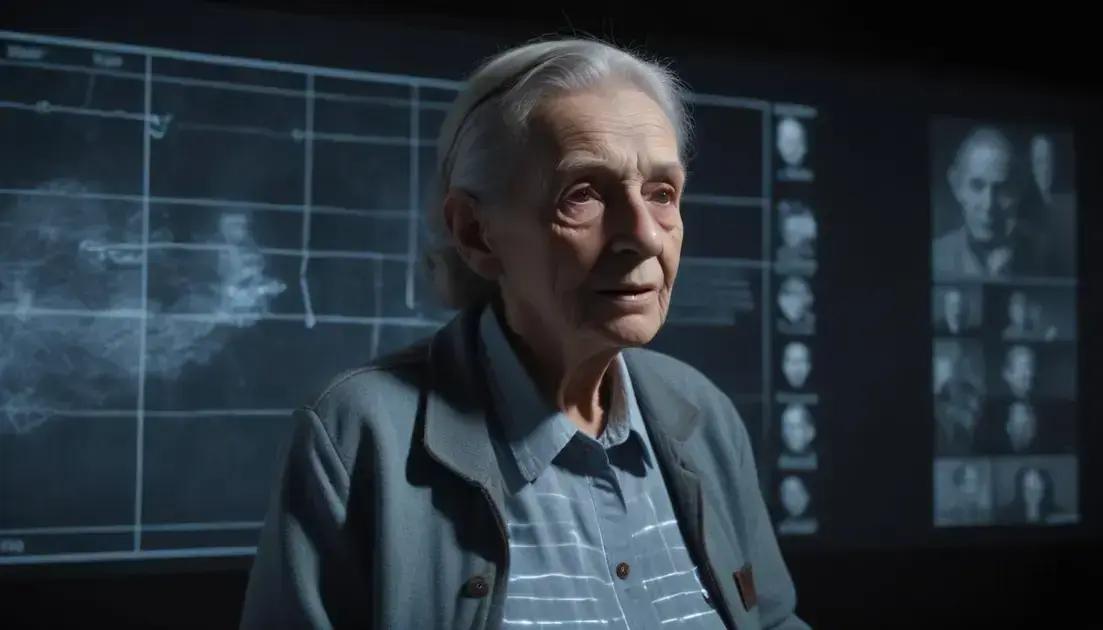AI Holocaust education Testimony 360: Preserving History Through Immersive Technology

AI Holocaust education Testimony 360 represents a groundbreaking approach to preserving the most critical human narratives of our time. By leveraging cutting-edge technology, we can ensure that the profound stories of Holocaust survivors continue to educate, inspire, and warn future generations about the dangers of hatred and intolerance.
The evolution of holocaust remembrance in the digital age
The digital age has dramatically transformed how we remember and educate about the Holocaust, shifting from traditional memorial methods to innovative technological approaches. Historical preservation now transcends physical archives, embracing digital platforms that ensure these critical narratives remain accessible and impactful.
Digital Archiving Techniques
Museums and institutions are now utilizing advanced digital technologies to capture, preserve, and share survivor testimonies. High-resolution scanning, metadata tagging, and cloud storage enable unprecedented levels of historical documentation and accessibility.
Multimedia Storytelling Platforms
Interactive websites, virtual reality experiences, and immersive digital exhibits are revolutionizing how younger generations engage with Holocaust history. These platforms transform passive learning into active, emotional experiences that foster deeper understanding and empathy.
Machine learning algorithms now help curate and contextualize historical documents, making complex narratives more comprehensible. Artificial intelligence assists in translating, categorizing, and connecting fragmented historical records, creating comprehensive digital narratives.
Global Collaborative Efforts
International digital archives now collaborate across borders, sharing resources and creating comprehensive databases that preserve testimonies from diverse geographical and cultural contexts. This global approach ensures a more nuanced, inclusive historical understanding.
The evolution of Holocaust remembrance in the digital age represents a critical intersection of technology, education, and human memory, ensuring that these profound stories continue to educate and inspire future generations.
How ai transforms survivor testimony collection
Artificial Intelligence is revolutionizing the way survivor testimonies are collected, preserved, and shared, introducing unprecedented technological capabilities to historical documentation. Machine learning algorithms now play a crucial role in capturing and protecting these irreplaceable narratives.
Advanced Digitization Techniques
AI-powered scanning technologies can now convert fragile physical documents and recordings into high-resolution digital archives. These systems use optical character recognition and audio transcription to create searchable, multilingual databases of survivor experiences.
Natural Language Processing in Testimony Analysis
Complex natural language processing algorithms help researchers analyze and categorize testimonies, identifying patterns, emotional nuances, and contextual details that might be missed through traditional methods. These technologies enable deeper, more nuanced understanding of individual experiences.
Machine learning models can now detect subtle linguistic variations, translate testimonies across multiple languages, and even predict potential gaps in historical documentation by cross-referencing multiple survivor accounts.
Preservation and Accessibility
AI technologies ensure that survivor testimonies are not just preserved but made accessible to global audiences. Interactive platforms use recommendation algorithms to connect researchers, educators, and students with relevant historical narratives, creating immersive learning experiences.
By transforming testimony collection, AI is creating a more comprehensive, accurate, and accessible historical record that honors the experiences of Holocaust survivors while making their stories available to future generations.
Virtual reality and immersive storytelling techniques
Virtual reality represents a groundbreaking approach to Holocaust education, transforming passive learning into immersive, emotionally powerful experiences. These technologies create unprecedented opportunities for genuine, empathetic historical understanding.
Interactive Narrative Environments
VR platforms now reconstruct historical settings with meticulous detail, allowing users to virtually walk through concentration camps, ghettos, and other significant Holocaust locations. Advanced spatial mapping and 3D modeling enable hyper-realistic environments that contextualize survivor experiences.
Emotional Engagement through Technological Innovation
By simulating historical scenarios, virtual reality helps break generational barriers, enabling younger audiences to connect emotionally with traumatic historical events. Immersive storytelling techniques translate abstract historical concepts into visceral, personal experiences.
Motion-capture technologies and AI-driven narrative algorithms allow for dynamic, responsive storytelling where users can interact with virtual representations of Holocaust survivors, asking questions and receiving contextually appropriate responses.
Multisensory Learning Experiences
Contemporary VR technologies integrate audio, visual, and even haptic feedback to create comprehensive learning environments. These multisensory approaches help learners develop deeper, more nuanced understanding of complex historical narratives.
Virtual reality transforms Holocaust education from a distant, academic exercise into a profound, personally transformative journey of remembrance and understanding.
Ethical considerations in ai-powered historical documentation
The integration of artificial intelligence in historical documentation demands rigorous ethical frameworks to protect survivor dignity and historical accuracy. Ethical considerations become paramount when technology intersects with sensitive human narratives.
Data Privacy and Consent
AI technologies must prioritize survivor consent and personal data protection. Sophisticated algorithms need robust protocols that anonymize personal information, respect individual privacy rights, and prevent potential misuse of traumatic testimonies.
Algorithmic Bias and Representation
Machine learning systems require careful design to minimize historical biases. Researchers must continuously audit AI models to ensure fair, comprehensive representation of diverse survivor experiences. This involves developing inclusive training datasets that capture nuanced perspectives.
Complex ethical challenges emerge when AI systems interpret historical narratives. Potential risks include oversimplification, decontextualization, and unintentional misrepresentation of lived experiences.
Psychological Impact and Trauma Sensitivity
Digital documentation technologies must integrate psychological expertise to handle trauma-based narratives responsibly. Interdisciplinary teams combining technologists, historians, and mental health professionals can develop more sensitive documentation approaches.
Maintaining human oversight remains crucial in AI-powered historical documentation, ensuring that technological innovation never undermines the fundamental human dignity of survivor testimonies.
Machine learning algorithms in preserving oral histories

Machine learning algorithms are transforming the landscape of oral history preservation, offering unprecedented capabilities in documenting, analyzing, and protecting survivor testimonies. These sophisticated technologies create new possibilities for historical research and memory preservation.
Advanced Transcription and Translation
AI-powered algorithms can now accurately transcribe multilingual testimonies, preserving linguistic nuances and providing instant translations. Natural language processing techniques help researchers identify key narrative elements, emotional contexts, and historical references within complex oral narratives.
Pattern Recognition and Contextual Analysis
Machine learning models can detect subtle patterns across multiple survivor testimonies, identifying interconnected experiences and corroborating historical details with remarkable precision. These algorithms help researchers uncover hidden connections and validate individual accounts through comprehensive data analysis.
Complex neural networks process audio and video testimonies, extracting emotional tone, linguistic characteristics, and contextual information that traditional archival methods might overlook.
Semantic Mapping and Knowledge Extraction
Advanced algorithms create detailed semantic maps of oral histories, connecting individual testimonies to broader historical contexts. This approach transforms isolated narratives into interconnected historical networks, providing researchers with rich, multidimensional understanding of complex historical experiences.
Machine learning technologies represent a critical tool in preserving and understanding oral histories, ensuring that individual memories remain accessible, comprehensible, and meaningful for future generations.
Interactive testimonies: bridging generational gaps
Interactive testimony technologies are revolutionizing how younger generations engage with historical narratives, creating profound connections across time and experience. These innovative platforms transform passive learning into active, emotional understanding.
Digital Dialogue Platforms
Advanced AI technologies now enable users to interact with virtual representations of Holocaust survivors. Through sophisticated natural language processing, these platforms allow users to ask questions and receive contextually appropriate, lifelike responses based on actual survivor testimonies.
Immersive Narrative Experiences
Interactive systems go beyond traditional documentary formats, creating personalized learning experiences that adapt to individual user engagement and emotional responses. Machine learning algorithms analyze user interactions, providing increasingly nuanced and empathetic historical narratives.
Virtual reality and augmented reality technologies simulate historical environments, allowing younger generations to virtually walk alongside survivors and experience their stories with unprecedented emotional depth.
Emotional Intelligence and Historical Empathy
These interactive platforms are designed not just to transfer information, but to cultivate genuine emotional understanding. Advanced algorithms help translate complex historical experiences into relatable, personal narratives that resonate across generational boundaries.
By bridging technological innovation with human storytelling, interactive testimonies create powerful educational tools that ensure Holocaust memories remain vivid, personal, and transformative for future generations.
Challenges of digitizing traumatic historical experiences
Digitizing traumatic historical experiences requires extraordinary sensitivity, technological precision, and deep ethical considerations. These challenges extend far beyond simple technological implementation.
Psychological Complexity of Digital Representation
Transforming deeply personal, traumatic narratives into digital formats demands nuanced approaches that respect survivors’ emotional landscapes. Machine learning systems must navigate complex psychological territories without reducing profound human experiences to mere data points.
Preserving Emotional Authenticity
AI technologies face significant challenges in capturing the subtle emotional nuances of traumatic testimonies. Advanced algorithms must learn to recognize and preserve the intricate emotional textures that traditional documentation methods might inadvertently flatten or erase.
Computational systems struggle to translate the profound human complexity of survivor experiences, requiring interdisciplinary collaboration between technologists, historians, and psychological experts.
Ethical Documentation Protocols
Developing robust ethical frameworks becomes crucial when digitizing sensitive historical narratives. Research teams must create comprehensive guidelines that prioritize survivor dignity, prevent retraumatization, and ensure informed consent throughout the digital documentation process.
The intersection of technological innovation and human trauma demands unprecedented levels of empathy, precision, and responsible technological design.
Global impact of ai-enhanced holocaust education
Artificial intelligence is transforming Holocaust education into a global, interconnected learning experience that transcends traditional geographical and generational boundaries. These technological innovations create unprecedented opportunities for worldwide historical understanding.
Cross-Cultural Learning Platforms
AI-powered educational technologies enable real-time translation and cultural contextualization of Holocaust narratives. These platforms allow students from different countries to access, understand, and engage with survivor testimonies in their native languages, fostering global empathy and historical awareness.
Collaborative Research Networks
Machine learning algorithms now connect historical archives across international institutions, creating comprehensive, multilingual databases of Holocaust documentation. This approach allows researchers to identify global patterns, validate historical accounts, and develop more nuanced understanding of complex historical experiences.
Advanced network mapping technologies help scholars visualize connections between testimonies, revealing intricate transnational narratives that traditional research methods might overlook.
Democratizing Historical Knowledge
AI technologies are breaking down educational barriers, making Holocaust education accessible to communities with limited resources. Online platforms with adaptive learning algorithms can customize educational content to different cultural contexts, ensuring that critical historical lessons reach diverse global audiences.
By leveraging artificial intelligence, Holocaust education becomes a powerful tool for promoting global understanding, empathy, and collective memory preservation.
Future of memorial technologies and collective memory
Memorial technologies are evolving rapidly, transforming how societies remember, process, and transmit traumatic historical experiences. Artificial intelligence is becoming a critical bridge between past narratives and future understanding.
Adaptive Memory Preservation
Emerging technologies enable dynamic, personalized memorial experiences that adapt to individual learning styles and emotional responses. Machine learning algorithms can now create highly contextualized historical narratives that resonate with different generations and cultural backgrounds.
Immersive Remembrance Platforms
Advanced neural networks are developing increasingly sophisticated methods of capturing and reconstructing historical memories. These technologies go beyond traditional archival approaches, creating interactive, emotionally intelligent platforms that preserve nuanced human experiences.
Quantum computing and artificial intelligence are converging to develop more complex, adaptive memorial technologies that can process and represent multidimensional historical narratives.
Ethical Technology Design
Future memorial technologies must balance technological innovation with profound ethical considerations. Interdisciplinary teams are developing frameworks that protect the integrity of historical testimonies while leveraging cutting-edge technological capabilities.
As memorial technologies evolve, they promise to create more empathetic, comprehensive approaches to collective remembrance, ensuring that critical historical lessons continue to resonate across generations.
AI Holocaust Education: A Technological Bridge to Collective Memory
Artificial intelligence represents more than a technological innovation in Holocaust education – it is a powerful mechanism for preserving human dignity, ensuring that survivors’ experiences remain vivid, accessible, and transformative.
The convergence of advanced technologies like machine learning, virtual reality, and ethical design creates unprecedented opportunities to bridge generational gaps, transcend geographical boundaries, and maintain the profound lessons of historical trauma.
As we move forward, these technologies are not just tools for documentation, but essential instruments for cultivating empathy, understanding, and preventing future atrocities. By leveraging AI’s capabilities, we can ensure that the memories of Holocaust survivors continue to educate, inspire, and warn future generations about the critical importance of human rights and compassion.
The future of memorial technologies lies not just in preserving historical narratives, but in creating immersive, emotional experiences that transform passive learning into active understanding.





